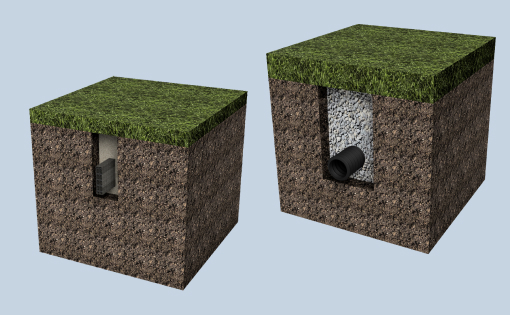
So, What Is a French Drain?
The French drain was invented in the mid-1800s. It revolutionized how people tackled drainage for construction and as a standing, general-purpose solution. A French drain consists of two basic parts. First, a trench is dug leading from the point of higher elevation to a lower area. This incline only needs to be slight, but because they operate via gravity (just like modern drainage systems), there needs to be a slope.
Once a trench has been dug, it is filled with rocks or gravel. The operating principle is that water wants to travel along the path of least resistance. Gravel is more porous than solid earth, and the trench acts as a way to guide water and prevent flooding.
The Next Evolution in Drainage
The French drain was an important innovation, but Hydraway has completely transformed the drainage industry.
Evolutions in Commercial Drainage Solutions
Since the original French drain was invented, there have been several iterative improvements to the design. Perhaps the biggest was the introduction of a perforated pipe. In a typical design, a rigid pipe is punctured on one side and placed into a trench with the holes facing down. Water can then rise in the trench, flow into the pipe, and flow out to where it should be deposited—safely away from a structure or field.
While these designs are more efficient and practical than a standard French drain with gravel alone, they still face problems—the biggest of which are clogging and erosion. First, if the pipe takes in more than just water—for instance, dirt or sand—it will become less efficient at moving water. If the pipe is allowed to gather too much outside material, it could weaken the structural integrity of your landscaping or the area near your drain.
Commercial French drain systems today, however, need to resist clogging and remove water more efficiently than ever. Hydraway is now leading the industry in innovative drainage that is clog resistant and has a proven zero-percent failure rate when properly installed.
The bottom line is that, whether you were using a traditional French drain or even a modern perforated pipe system, they are bound to fail eventually. The Hydraway system is easy to install, and we can also consult on your projects to ensure everything goes as planned. One of the worst things that could happen—and the highest French drain cost—would be a drainage failure years later. With Hydraway, you can prevent that scenario.
Hydraway Flow Rate Demo
There are several French drain options available on the market today. However, none can compare to the compressive strength, guaranteed results, and, as shown in the video, in-flow rate.
Flow ratings are only a measure of how quickly water flows from the pipe. The more important question is, “What is the in-flow rate?”
Standing water leads to several potentially disastrous consequences. Not only is it unsightly and a breeding ground for mosquitoes, but it can cause property damage. Particularly, when water is sitting next to underground foundations, it will exert hydrostatic pressure, which leads to leaking and cracks.
A drainage system without a high enough in-flow rate will not be able to remove water during floods and heavy rainfall. Hydraway has the highest inflow rates of any drainage system on the market today – up to 70% greater than traditional corrugated and perforated pipe and drainage systems. The in-flow rate of Hydraway is the result of the patented core design that creates these superior results. Once water enters the system, gravity takes over from there.
Plus, the needle-punctured fabric exterior blocks contaminants from entering the system. Beyond the high-quality manufacturing of the system itself, this is the feature that ensures the long effective life of the Hydraway system.
Watch the video demonstrating Hydraway’s superior in-flow rate and judge yourself.
| SYSTEM | FLOW RATING/LINEAR FOOT PER (ASTM 4716) | “IN-FLOW” RATING (OR PERMEABILITY RATE) IN % OF THE OPENINGS ACROSS THE SURFACE | 4-GALLON BUCKET TEST (TIME ELAPSED IN SECONDS FOR WATER TO EMPTY) |
|---|---|---|---|
| 4″ Perforated Pipe | 32 gal | 4-5% | 27 |
| Gravity (WaterGuard) System | 8-9% | 23 | |
| Hydraway Single Layer | 10.5 gal | 75% | 11 |
| Hydraway Double Layer | 10.5 | 75% | 6.5 |
Contact Us
Please complete the form below for more information on our solutions or to learn about our distributor’s program.

